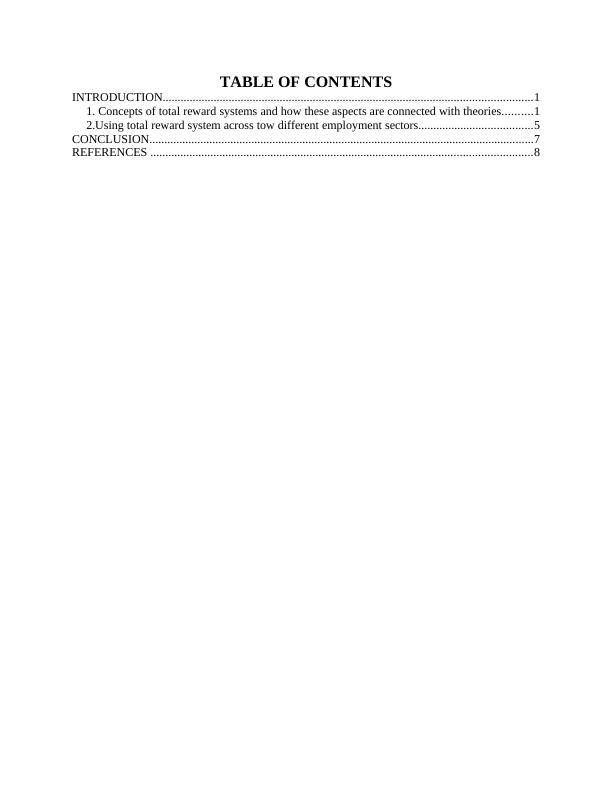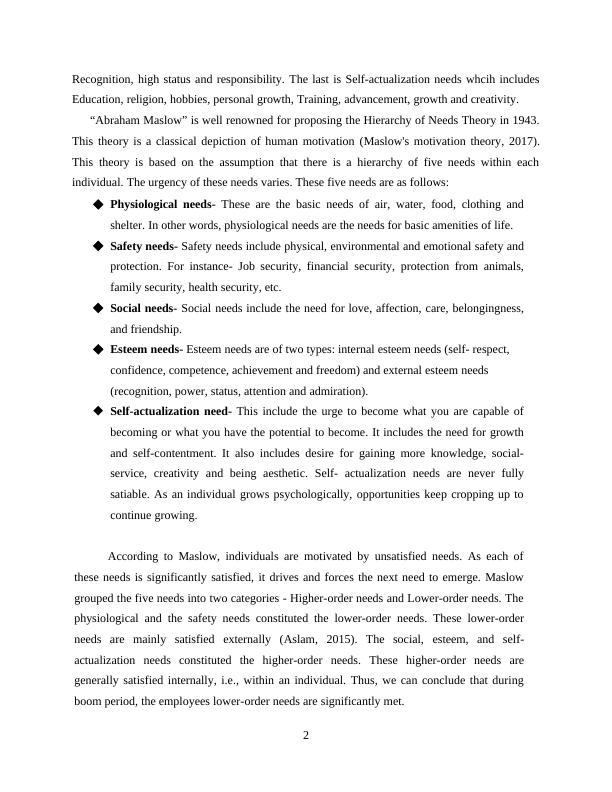Report on Total Reward System
Added on 2020-06-05
11 Pages3406 Words59 Views
Total Reward System

TABLE OF CONTENTSINTRODUCTION...........................................................................................................................11. Concepts of total reward systems and how these aspects are connected with theories..........12.Using total reward system across tow different employment sectors......................................5CONCLUSION................................................................................................................................7REFERENCES ...............................................................................................................................8

INTRODUCTIONMotivating employees on continual basis is referred to be one of the most concerningagenda of almost all sort of organizations in today’s contemporary world. This is mainly due toits leading number of benefits where a motivated workforce is apparent to give productive resultsto the organization. It is also on considering a fact where encouraged workers are known to havea vital sense of commitment in them towards serving organizational goals and objectives on dueperiod. They operate with a more enthusiastic approach for a timely completion of their assignedwork. This in turn assists organizations to a great extent where they could refer to get productiveoutcome from workers that also helps them in rising their sales and profitability level.It is however referred to be a primary responsibility of the organizational bodies toundertake a tactical approach for intensifying the satisfaction level of their employees. Thepresent essay has discoursed upon such similar prospective of motivational techniques with theuse of a well-known strategy called total reward system. Herein, the total reward system hasbeen referred to be a tool for motivating the workers in an effective manner. For this purpose,two different employment sectors namely retail and hospitality has been taken into considerationwith a comparative use of total reward system in both the fields. Herein, a renownedorganization named TESCO operating in the retail sector of UK and Hilton Hotel in the field ofhospitality industry has been chosen for exploring the use of total reward system by them. 1. Concepts of total reward systems and how these aspects are connected with theoriesAccording to Aslam, Ghaffar and Musthaq, (2015), the concept of total reward systemincludes everything the employee perceives to be value resulting from employment relationship.As per Bradley (2017), the concept of total rewards system represents dynamic relationshipbetween employers and employees. With the help of this reward system a healthy and ongoingrelationship between company and its employees is maintained. Maslow Need Hierarchy Theory of Motivation: This theory is based on five importantneeds first is Physiological needs which includes Food, water, shelter, Health, air and basicsalary. Second is Safety needs which includes safety from war, poison, violence, Work safety,job security and health insurance. Third is Belonging ness or social needs which includes needsof Family, friends, clubs, Teams, departments, coworkers, client, superiors and subordinates.Forth one is Esteem needs which includes Approval of family, friends and community,1

Recognition, high status and responsibility. The last is Self-actualization needs whcih includesEducation, religion, hobbies, personal growth, Training, advancement, growth and creativity.“Abraham Maslow” is well renowned for proposing the Hierarchy of Needs Theory in 1943.This theory is a classical depiction of human motivation (Maslow's motivation theory, 2017).This theory is based on the assumption that there is a hierarchy of five needs within eachindividual. The urgency of these needs varies. These five needs are as follows:Physiological needs- These are the basic needs of air, water, food, clothing andshelter. In other words, physiological needs are the needs for basic amenities of life. Safety needs- Safety needs include physical, environmental and emotional safety andprotection. For instance- Job security, financial security, protection from animals,family security, health security, etc. Social needs- Social needs include the need for love, affection, care, belongingness,and friendship. Esteem needs- Esteem needs are of two types: internal esteem needs (self- respect, confidence, competence, achievement and freedom) and external esteem needs (recognition, power, status, attention and admiration). Self-actualization need- This include the urge to become what you are capable ofbecoming or what you have the potential to become. It includes the need for growthand self-contentment. It also includes desire for gaining more knowledge, social-service, creativity and being aesthetic. Self- actualization needs are never fullysatiable. As an individual grows psychologically, opportunities keep cropping up tocontinue growing. According to Maslow, individuals are motivated by unsatisfied needs. As each ofthese needs is significantly satisfied, it drives and forces the next need to emerge. Maslowgrouped the five needs into two categories - Higher-order needs and Lower-order needs. Thephysiological and the safety needs constituted the lower-order needs. These lower-orderneeds are mainly satisfied externally (Aslam, 2015). The social, esteem, and self-actualization needs constituted the higher-order needs. These higher-order needs aregenerally satisfied internally, i.e., within an individual. Thus, we can conclude that duringboom period, the employees lower-order needs are significantly met.2

End of preview
Want to access all the pages? Upload your documents or become a member.
Related Documents
Executive Master of Human Resource Management (EMHRM)lg...
|10
|2327
|23
Total Reward System Assignment Doclg...
|16
|3629
|82
Introduction to motivation theorylg...
|22
|4381
|384
Motivation Techniques of Jacklg...
|8
|1436
|42
Employee Motivation and Factors Affecting Job Performancelg...
|9
|2274
|198
Motivational Theories and Structured Interview Process: Causes of Poor Motivation in Production Workers and Poor New Hire Selectionslg...
|7
|1107
|268
